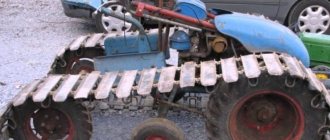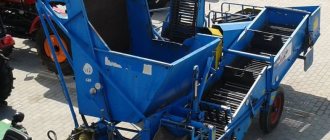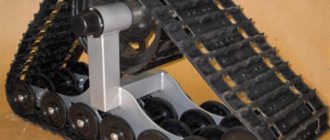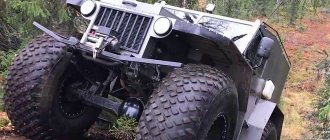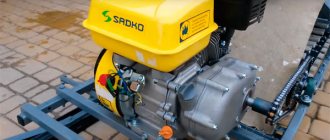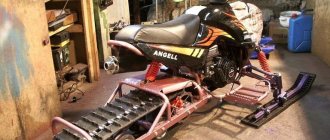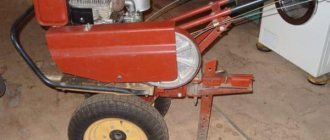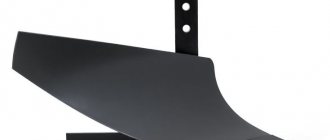Which motorcycles are best suited for conversion into an all-terrain vehicle (snowmobile)? During the snowy winter period, many motorcycle owners come up with the idea of creating an all-terrain vehicle out of their motorcycle. To do this, you need to install the caterpillar on the wheels. In principle, this can be done with any “iron horse,” but most users agree that the best domestic unit for such a change is the Dnepr, Izh, or Ural motorcycle.
Even during the Second World War, a German motorcycle on tracks was known, which was designed by the inventor Heinrich Ernst Kniepkamp. At first it was used only by German paratroopers, but later became more common as a traction force. It continued to exist after the war; the remaining models were actively used in agriculture.
Two main types of all-terrain vehicles
In our huge country there are a large number of craftsmen who can create a winter form of transport from a motorcycle or walk-behind tractor. All of them have at least basic knowledge of auto mechanics, a certain number of spare parts for motorcycles, and a lot of imagination. Each such vehicle is unique, but they have something in common. Some authors place their equipment on a caterpillar track, others install a structure with skis in place of the wheels. Leading skis can be either front or rear skis.
Before you conjure up your favorite motorcycle, you need to stock up on some knowledge or the help of knowledgeable designers. After all, your equipment may break. But often in our conditions it is impossible to simply drive in the snow. This kind of riding is similar to driving on sand or mud, but in deep snow the motorcycle can even stall, and it won’t be able to travel on every rut. Therefore, we choose the lesser of two evils and still decide to make changes.
Features of manufacturing tracks for motorcycles
Of course, you can always buy factory-made snowmobile skis or track wheels. Then the need to invent something will disappear. But we are not looking for easy ways, and not everyone has the opportunity to purchase new spare parts. Sometimes it's not the price or the fact that the parts are hard to find. For some people, it’s a hobby to create their own “transformer” and ride it around their town. That's why we decided to put together some tricks that different craftsmen use to create their snowmobiles to make your creative process easier.
Best materials
Most craftsmen use a material such as aluminum to make spare parts. It lends itself well to deformation, is easy to drill, grind, and is not heavy, which will help give your vehicle additional maneuverability.
Caterpillars are made from spiked rubber, tires, and chains. For their manufacture, sheet steel is most often used. Now let's figure out how to build a snowmobile or all-terrain vehicle from a motorcycle.
Physical Features
When designing such a vehicle, you need to remember several important laws of physics, without knowledge of which your work will be reduced to zero. For good cross-country ability on a snowy surface, you need to make the contact area with the coating as large as possible. This will help the snowmobile not to fall through. In order to reduce the load on the snow cover, you need to make the weight of your vehicle as small as possible. In order for your snowmobile to be stable, another law of physics should be applied - you need to make at least three points of support. That is, a snowmobile with three skis will be more stable when moving than with two. The design may consist not only of skis, but, for example, of one track and two skis or, conversely, of a ski and a pair of tracks. There can be four support points, then you will get something resembling an ATV.
Most often, such units as “Dnepr”, “Izh” are used for such conversion; you can also find a “Ural” motorcycle on tracks. The steering part is left original; all the necessary systems are connected to it - clutch, gas lever. Steel pipes or angles are used for the frame. To make the ski, sheet steel and again angles are used.
TRACKED…MOTORCYCLE
The need to ensure the required ground clearance, as well as to obtain optimal (rather low) speeds of the drive wheel-roller of the caterpillar, forced the use of an intermediate chain drive-reducer in the transmission, for which there are corresponding brackets on the frame with grooves that allow tensioning the chain of the first stage (chain pitch - 12, 7 mm). The transmission of rotation from the gearbox to the drive wheel-roller of the caterpillar propulsion unit is also carried out by a chain from agricultural machinery (pitch - 15.785 mm). This chain has a more significant resource in dirty conditions, compared to a motorcycle chain. As has already become clear, the caterpillar propulsion unit consists of a caterpillar and two rollers - drive and tension wheels. Previously, between the wheels on both caterpillar tracks there were two more supporting small sloth rollers (see photo of the screensaver). But operation has shown that a well-tensioned track with such a small distance between the wheels and without sloths holds the load well.
The drive and tension wheels of the caterpillar mover are the same, from the Tulitsa motor scooter (or similar ones), and transverse grooves are cut on the drive tire (without touching the cord) for engagement with the track lugs. Both wheels have independent suspensions. Each of them is installed in its own pendulum fork, articulated with the frame through silent blocks (from the Voskhod motorcycle).
At the ends of the pendulum forks there are grooves for moving the wheels to tension the track, and they rest on the frame through simple shock absorbers (pipe to pipe, with springs from the Voskhod front fork), which ensures a minimum weight. Rocking does not occur due to the distribution of the load over the wheels of the caterpillar mover. The wheel rims are standard, but lightened by drilling. The hubs are inserted into the central holes of the disks and secured with welded spokes-struts made of 5 mm wire.
For the hubs, a cylindrical body from a car hand pump is used, its internal diameter is just suitable for the 202nd bearing, and so that the latter (there are two of them in the hub) do not fall through, sections (rings) of a suitable pipe of a smaller diameter are inserted inside and fixed through the holes in the hub electric rivets. Since the hub flange is flat and thin-walled, for rigidity on both sides it is reinforced with struts made of 5 mm wire, which distribute the load to the edges of the hub. The shaft of the front (drive) wheel of the caterpillar and the rear (tension) axle are made of a pipe with a diameter of 16×2.5 mm and the middle part is lightened (turned). Snow and dirt get clogged between the struts, so it is better to fill them with Macroflex and paint them. By the way, all niches and voids, including the internal cavity of the front wheel (steered pneumatic), are also filled with foam.
The protection of wheel bearings requires special attention - they operate in conditions of intense contamination, so they must be well protected with covers or bearings with protective washers must be used. The track drive wheel has two bearings on the sprocket side for reliability, and the hub tube has additional pads on top to distribute the load.
The caterpillar is assembled from 2 strips of nylon cord tape and lugs made from 8 mm wire rod and reinforced in the middle part with another piece of the same wire. To connect the lug strips to the lug strips, sections of channels bent from a 4-mm sheet are welded to the latter, to which the caterpillar strips are bolted.
Crawler mover: wheel discs are lightened with drilled holes; their attachment to the hubs is reinforced with spokes; grooves are cut into the drive wheel tire for track brackets.
Front wheel: tire lightened - tread removed; the wheel rims are solid, and the space between them is filled with construction foam; The tires are bolted to the rims.
I pay attention to the shape of the lug - it follows the profile of the tire. The ends of the wire rod must be beveled for unhindered entry of the drive wheel, and the welds must be thoroughly cleaned. Of course, the oval shape of the lugs also has “disadvantages” - slipping of the caterpillar on compacted snow, as well as lateral sliding on ice due to the oval shape of the lugs, but this drawback is insignificant, what is more important is the ease of control of the motorcycle when cornering, which is why this form of lug is made. With a straight (flat) lug, it will be difficult to maintain balance, especially when turning (tested!). The drive and tension wheels of the tracked unit have newly manufactured hubs - due to the significant mass of the standard ones.
Now about the “minor” nodes. The 12-liter fuel tank is argon-welded from a 1-mm aluminum sheet (AMG-2) and has partitions inside (otherwise, with a large length and low height of the tank, fuel will be released into the drain).
Muffler:
1—primary chamber (pipe Ø 60×1); 2—inlet pipe fitting; 3 - intermediate chamber; 4—connecting pipe of the primary and secondary chambers (pipe Ø 32×1) with holes Ø 5; 5—secondary chamber (pipe Ø 60×1); 6—outlet pipe (pipe Ф25х1); 7—fastening eye with a jumper (steel sheet s3).
Transmission - two-stage chain drive with intermediate shaft:
1—power unit; 2—output shaft of the power unit; 3—engine output shaft sprocket (z = 13); 4—chain PR-12.7 of the first stage; 5—intermediate shaft support (friction bearing 80204, 2 pcs.); 6—drive sprocket of the intermediate gearbox (z = 21), 7—intermediate shaft; 8—driven sprocket of the intermediate gearbox (z = 18); 9—chain PR-15.875 of the second stage; 10—drive sprocket of the track drive wheel (z = 21, t = 15.875); 11 — drive wheel hub; 12—track drive wheel, 13—hub bearing (2 pcs.); 14—drive wheel axis.
The entire “facing” (sidewalls) and the front wing are also made of AMG-2. The headlight is plastic, installed for protection between the jibs of the front fork. The wind shield is also made from AMG-2, removable, and is mounted on four wings.
The driver's seat is removable (its base is made of AMG-5 with a thickness of 2.5 mm), under it there are two compartments, the walls of which are also made of light alloy sheet. The first contains a relay-regulator, and the second contains a tool.
In the future, when switching to a thyristor ignition system, the relay-regulator compartment is supposed to be used as an air purifier.
The exhaust muffler is made of extremely compact 1 mm steel, not dismountable, the noise level during engine operation is comparable to the exhaust of road motorcycles. About twice a year it has to be burned from the motor oil that cokes in it.
All electrical equipment (generator, relay regulator) is standard, as is the K-36G carburetor. In the future, it is planned to install a valve block (based on materials from “Modelist-Constructor”). The footrests are tubular and retract back and up. The steering wheel is from the Voskhod, but expanded by a 150 mm insert; the controls on it are the same as on road motorcycles. Behind the driver's seat there is a cargo area, handles are welded to it on three sides for pulling the motorcycle out of the quagmire (and this sometimes happens!), They also serve as hooks for slinging the load.
There is a hitch under the trunk. It was installed later, and, admittedly, not entirely successfully (that’s why I didn’t show this device in the drawing). It must be covered with a mudguard so that it does not get covered with dirt. However, you should not raise the coupling device high (you will have to make a long trailer tongue).
Chain drive with an intermediate shaft-reducer: in the foreground, above the driven sprocket of the intermediate shaft, the engine output shaft sprocket and the first-stage PR-12.7 chain are visible.
Under the driver's seat there is a small electrical compartment and a tool box.
Crawler all-terrain motorcycle with trailer.
As already mentioned, the voids under the seat (behind the tool compartment) and the trunk are filled with foam; in combination with the front wheel, they ensure that the motorcycle is unsinkable, which is quite important in recent warm winters. Agree that this is still better than getting a motorcycle from the bottom of a reservoir. The front wheel has a low-pressure tire made from lightweight UAZ tires. The manufacturing method is described in the “Model Designer”, but I note that it is not necessary to make a “checker” - the clutch is quite enough if you cut a shallow “herringbone” with a grinder.
All transmission chains are covered with AMC-2 casings, this reduces their contamination and ensures driver safety. The drive wheel chain casing is collapsible to make it easier to remove the wheel and repair the casing in the event of a breakdown (this happens when driving through a windfall). The casing was left open at the bottom (so that snow or dirt would not linger in it), and the chain, which sagged at high speeds, did not touch the bottom.
Since a tracked motorcycle is an off-road vehicle, due to the complexity of its design, it was not equipped with brakes, and there is no particular need for them. I make planned stops by gradually reducing the speed due to friction in the transmission (you can also slow down with your foot - the speed is low). I perform emergency braking with the engine - I sharply release the gas or turn off the ignition (I used the latter method only as a training).
A. KOKSHAROV, Loukhi village, Karelia
We recommend reading
- AQUAPEDES The fact that you can move through water by sitting on a log and pushing off from the water with the first stick you come across has been known for many thousands of years. Over such a long historical period...
- CABINET-COLUMBER Most hallway cabinets have one drawback: they cannot accommodate long items, such as skis or a household stepladder. Suggested for…
Track manufacturing technology
Making a caterpillar for a motorcycle with your own hands is not difficult for those in the know. Let's look at the most common method.
We make the caterpillar for the motorcycle from a conveyor belt, which we divide into 4 parts. The resulting strips are 5.5 cm wide. We assemble them into a single structure using U-shaped profiles. The track supports need to be balanced. Balancers are made of steel sheets. We cut out the halves of the disks using stamps. We take bronze hubs or grind them ourselves.
Then we connect the half-disks with six bolts. The blanks for balancing are ready. It is necessary to make shafts for the support drums at the front and rear. They are made from steel rod. They make holes for the bearings and insert them there. The support drums are made of aluminum or duralumin parts. Then the structure is connected with bolts. When installing, rubber sprockets are inserted between the support drums.
And now the caterpillar on the motorcycle is already rotating from the chain. A special unit, which is attached to the ear of the bushing at the front, helps to fix this entire structure on the back of the all-terrain vehicle. Two such ears are needed; they should be welded onto the longitudinal pipes and the previously made balancers should be attached. Here is the main part of the work that allows you to make a snowmobile on tracks from a motorcycle.
Caterpillars for walk-behind tractor
Now it’s time to learn how to make tracks on a walk-behind tractor with your own hands. We say right away that the procedure is very similar to assembling conventional tracks for an all-terrain vehicle.
In the same way, you need to weld together professional pipes with a cross-section and give them the shape of an English letter V.
The only difference will be the fastening on the sides using bushing-roller chain screws.
Finally, measure the length of the caterpillar, and if it is slightly larger than necessary, then simply remove a few extra cm of the corrugated pipe.
Second life for old tires
There is another well-known method. Let's look at how to make a homemade motorcycle track using old tires. For such work, it is best to choose tires from large trucks. It is better that the tread pattern is kept in satisfactory condition. To work, we will need a very sharp shoe knife and some cutting skills, no matter how strange it may sound. In the manufacture of such a caterpillar, the method of cutting out the sides from tires is used. To ease the effort when cutting thick tires, you need to periodically dip the knife in a soapy solution. You can also use an electric jigsaw with fine teeth.
So, for old tires we remove the beads, select parts with a well-preserved tread pattern, or we will have to cut it ourselves to improve grip on the road surface. The undoubted advantage of such a tire chain is that it consists of a closed solid material, which means it is more resistant to breaks. The disadvantage of this design is the limited tire size.
Caterpillar for UAZ
Next we will tell you how to make tracks on an UAZ with your own hands. For this model, a caterpillar made from ordinary car tires is suitable. Select a massive truck tire in advance.
Be sure to pay attention to the characteristic tread pattern. If it has triangular cutouts, then the tire will fit.
To make it, you need to carefully cut out the sides and, most importantly, do not forget to leave space for the treadmill. Then start connecting the resulting tires using car belts.
The result of the work will be a ready-made caterpillar for operation by the UAZ all-terrain vehicle.
All in your hands!
We see that you can convert any motorcycle or walk-behind tractor, put it on tracks, skis, or combine it. Fantasy is not limited by anything except its own capabilities. First, look around your garage - maybe you already have a caterpillar for a motorcycle in stock. If so, you can begin assembly. Even if you are using a track for a motocross motorcycle, do not forget about safety, which should come first. You need to think not only about yourself, but also about those around you who you may harm. Take a test drive in a deserted area. Was the test drive a success? Now we're off to the track!
There are a huge number of options, all of them unique in their own way. They can safely be classified as handmade, because almost every detail is made individually. The choice of materials and manufacturing methods is also huge. In addition to a standard set of plumbing tools, you will definitely need a welding machine, possibly a pipe bender, an angle grinder, etc. But one thing is clear: making a track for a motorcycle and turning it into a snowmobile yourself is much more interesting, and most importantly, cheaper than simply purchasing ready-made components.
All-terrain vehicle tracks
As a rule, tracks for homemade all-terrain vehicles are made from high-strength conveyor belt, which lends itself well to various types of deformation while driving. It does not require special care; all you need is to clean it from dirt from time to time.
So, let's now talk more about creating caterpillars. For work you will need the following materials:The tape contains professional pipes with a characteristic cross-section; it is with their help that the all-terrain vehicle can cover distances in the most unfavorable weather.
- Bolts and nuts of various shapes and sizes.
- Profiled pipe with cross-section.
- Massive fittings.
- Conveyer belt.
You should also have the following tools in your arsenal:
- Powerful drill.
- Welding machine.
- Big hammer.
- Universal set of wrenches.
- Track pressing machine.
Based on the size of the track, you need to prepare the appropriate bolts and nuts. Next, take the reinforcement and start shaping it into a rounded shape using a crimping machine. Then, using a welding machine, you need to weld the letter V at the top of the reinforcement.
For a more detailed understanding of the steps, we recommend watching a video on how to make caterpillars with your own hands.
After the work has been done, you will have a homemade track that needs to be attached to another track, etc. The result of the work will be a reliable track for an all-terrain vehicle.
